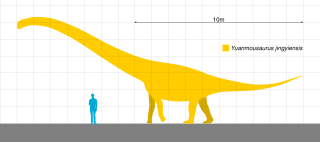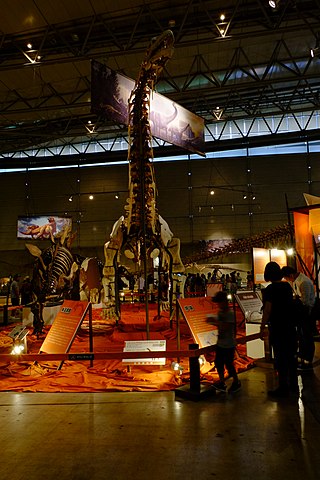
Mamenchisaurus is a genus of sauropod dinosaur known for their remarkably long necks which made up nearly half the total body length. Numerous species have been assigned to the genus; however, the validity of these assignments has been questioned. Fossils have been found in the Sichuan Basin and Yunnan Province in China. Several species from the Upper Shaximiao Formation, whose geologic age is uncertain, have been described. However, evidence suggests this formation to be no earlier than the Oxfordian stage of the Late Jurassic. M. sinocanadorum dates to the Oxfordian stage, and M. anyuensis to the Aptian stage of the Early Cretaceous. Most species were medium-large to large sauropods, measuring roughly 15 to 26 meters in length—possibly up to 35 meters (115 ft), based on two undescribed vertebrae.

Euhelopus is a genus of sauropod dinosaur that lived between 145 and 133 million years ago during the Berriasian and Valanginian stages of the Early Cretaceous in what is now Shandong Province in China. It was a large quadrupedal herbivore. Like sauropods such as brachiosaurs and titanosaurs, Euhelopus had longer forelegs than hind legs. This discovery was paleontologically significant because it represented the first dinosaur scientifically investigated from China: seen in 1913, rediscovered in 1922, and excavated in 1923 and studied by T'an during the same year. Unlike most sauropod specimens, it has a relatively complete skull.

Bellusaurus was a small short-necked sauropod dinosaur from the Late Jurassic (Oxfordian) which measured about 4.8 metres (16 ft) long. Its fossils were found in Shishugou Formation rocks in the northeastern Junggar Basin in China.
Daanosaurus was a genus of dinosaur. It was a sauropod which lived during the Late Jurassic. It lived in what is now China, and was similar to Bellusaurus.

Hudiesaurus is a herbivorous sauropod genus of dinosaur from China. Its fossil remains were found in 1993 by a Chinese-Japanese expedition near Qiketai in Shanshan, Xinjiang province. The genus contains a single species, Hudiesaurus sinojapanorum, was named and described by Dong Zhiming in 1997. The generic name is derived from Mandarin hudie, meaning "butterfly," and refers to a flat butterfly-shaped process on the front base of the vertebral spine. The specific name refers to the members of the Sino-Japan Silk Road Dinosaur Expedition but can also be read as "central part" in Chinese, a pun on the Japanese Chunichi Shimbun press group, which financed the research.

Klamelisaurus is a genus of herbivorous sauropod dinosaur from the Middle Jurassic Shishugou Formation of China. The type species is Klamelisaurus gobiensis, which was named by Zhao Xijin in 1993, based on a partial skeleton discovered in 1982 near the abandoned town of Jiangjunmiao. Zhao described Klamelisaurus as the only member of a new subfamily, Klamelisaurinae, among the now-defunct primitive sauropod order Bothrosauropodoidea. Since Zhao's description, Klamelisaurus received limited attention from researchers until Andrew Moore and colleagues redescribed it in 2020.

Yuanmousaurus was a sauropod dinosaur from the Middle Jurassic period of China. It is known from incomplete remains, recovered in 2000 from the Zhanghe Formation in Yuanmou County in Yunnan Province. Yuanmousaurus was a relatively large sauropod and may have reached about 17 meters (56 ft) in length. It was a basal member of the Sauropoda, but its exact systematic position is unclear. A recent study placed Yuanmousaurus within the family Mamenchisauridae. It may be a dubious genus. The only and type species was Yuanmousaurus jiangyiensis.

Phuwiangosaurus is a genus of titanosaur dinosaur from the Early Cretaceous (Valanginian-Hauterivian) Sao Khua Formation of Thailand. The type species, P. sirindhornae, was described by Martin, Buffetaut, and Suteethorn in a 1993 press release and was formally named in 1994. The species was named to honor Princess Maha Chakri Sirindhorn of Thailand, who was interested in the geology and palaeontology of Thailand, while the genus was named after the Phu Wiang area, where the fossil was discovered.

Euhelopodidae is a family of sauropod dinosaurs of disputed membership and affinities, which contains Euhelopus and its close relatives. Most proposed euhelopodids are from East Asia.

Camarasauridae is a family of sauropod dinosaurs. Among sauropods, camarasaurids are small to medium-sized, with relatively short necks. They are visually identifiable by a short skull with large nares, and broad, spatulate teeth filling a thick jaw. Based on cervical vertebrae and cervical rib biomechanics, camarasaurids most likely moved their necks in a vertical, rather than horizontal, sweeping motion, in contrast to most diplodocids.

Daxiatitan is a genus of sauropod dinosaur known from the Lower Cretaceous of Gansu, China. Its type and only species is Daxiatitan binglingi. It is known from a single partial skeleton consisting of most of the neck and back vertebrae, two tail vertebrae, a shoulder blade, and a thigh bone. At the time of its discovery in 2008, Daxiatitan was regarded as potentially the largest known dinosaur from China.

Eusauropoda is a derived clade of sauropod dinosaurs. Eusauropods represent the node-based group that includes all descendant sauropods starting with the basal eusauropods of Shunosaurus, and possibly Barapasaurus, and Amygdalodon, but excluding Vulcanodon and Rhoetosaurus. The Eusauropoda was coined in 1995 by Paul Upchurch to create a monophyletic new taxonomic group that would include all sauropods, except for the vulcanodontids.

The Early Cretaceous Phu Kradung Formation is the lowest member of the Mesozoic Khorat Group which outcrops on the Khorat Plateau in Isan, Thailand. This geological formation consists of micaceous, brown to reddish-brown siltstone beds with minor brown and grey shale and sandstone beds. Occasional lime-noduled conglomerate occurs.

Xianshanosaurus is a genus of sauropod dinosaur from the Early Cretaceous (Aptian-Albian) of the Ruyang Basin in Henan Province, China. Its type and only species is Xianshanosaurus shijiagouensis. It was described in 2009 by a team of paleontologists led by Lü Junchang. Xianshanosaurus may be a titanosaur, and Daxiatitan may be its closest relative, but its evolutionary relationships remain controversial.
Wamweracaudia is a large herbivorous sauropod dinosaur from the Late Jurassic Tendaguru Formation of Tanzania, Africa, 155-145 million years ago.
Fushanosaurus is a genus of sauropod dinosaur from the Shishugou Formation from Xinjiang Province in China. The type and only species is Fushanosaurus qitaiensis. It is solely known from the holotype specimen FH000101, a complete right femur.
Rhomaleopakhus is a genus of mamenchisaurid sauropod, dinosaur from the Late Jurassic Kalaza Formation of China. The type and only species is Rhomaleopakhus turpanensis.
Ruixinia is an extinct genus of somphospondylan titanosauriform dinosaur from the Early Cretaceous (Barremian) Yixian Formation of China. The genus contains a single species, Ruixinia zhangi. The Ruixinia holotype is a partial articulated skeleton with the most complete series of caudal vertebrae known from any Asian titanosauriform.

Minimocursor is a genus of basal neornithischian dinosaur from the Late Jurassic Phu Kradung Formation of Thailand. The type species is Minimocursor phunoiensis.



























